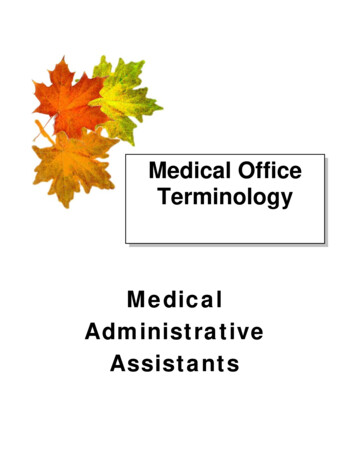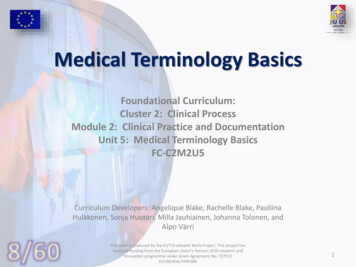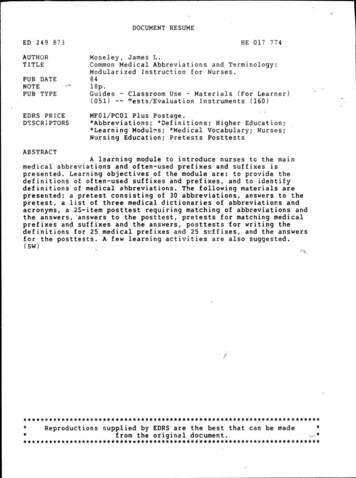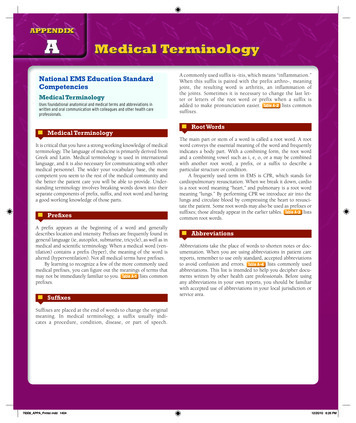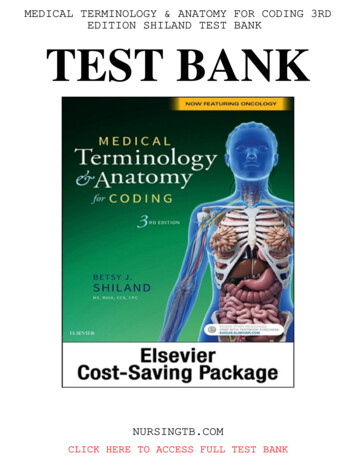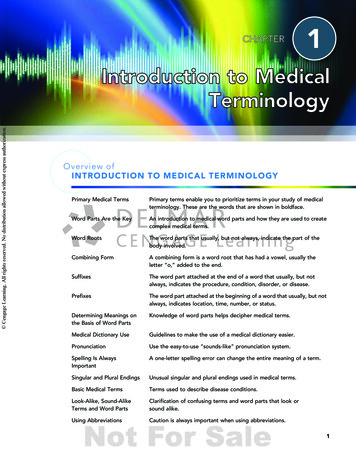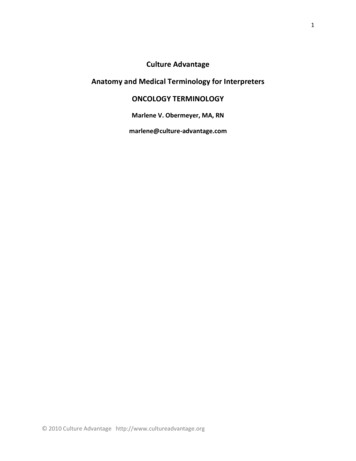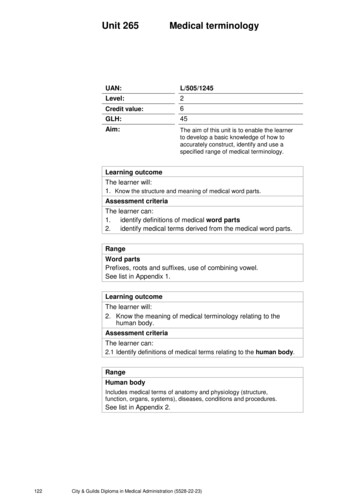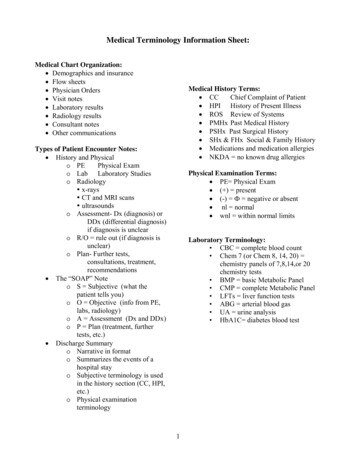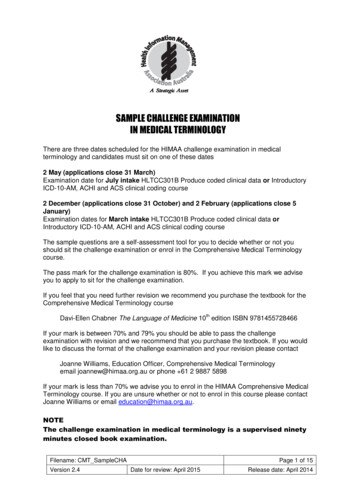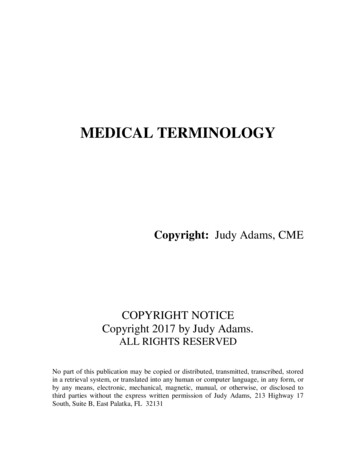
Transcription
MEDICAL TERMINOLOGYCopyright: Judy Adams, CMECOPYRIGHT NOTICECopyright 2017 by Judy Adams.ALL RIGHTS RESERVEDNo part of this publication may be copied or distributed, transmitted, transcribed, storedin a retrieval system, or translated into any human or computer language, in any form, orby any means, electronic, mechanical, magnetic, manual, or otherwise, or disclosed tothird parties without the express written permission of Judy Adams, 213 Highway 17South, Suite B, East Palatka, FL 32131
PreviewGoals and Objectives:As allied health professionals we have moved into a more medical realm, and our needfor a strong medical vocabulary has become greater. Since it would be impossible tomemorize all of the terms with which you must become familiar, it will be an easier taskto master if you understand more about the way medical terms are combined or puttogether. Smaller pieces of words are joined together to build a meaning. If you canunderstand the basics of the small parts, then it will be easier to decipher the meaning ofwords that are unfamiliar to you. This home study unit will concentrate on medical termsthat you will commonly use when communicating with other professionals in the healthcare industry.When you complete this study unit you will be able to: Identify many of the common roots, prefixes, and suffixes that are used in the hairremoval profession Determine the meaning of medical terms by analyzing their component parts Familiarize yourself with medical specialties Learn the correct pronunciation of medical words2
Using this study unit:So you will be able to learn the correct pronunciation of these medical terms, a phoneticspelling of each new word will be included in the material. You will find this phoneticspelling in parenthesis after the term. This method spells the word as it actually sounds.Always say the word out loud as you read and learn new terms. The basic rules are fairlysimple.1. Vowel sounds that are marked with a straight line above them are called ‘long’vowel sounds. For example the phonetic spelling of mate is māt, the phoneticspelling of bite is bīt, the phonetic spelling of home is hōm, and so on.2. Short vowel sounds are marked with a breve ( ) over them. Therefore, thephonetic spelling of bat is băt, the phonetic spelling of met is mĕt, the phoneticspelling of bit is bĭt, and so on.3. The primary stress in a word is indicated by a single boldface accent (’) and thesecondary stress is indicated by a double lightface accent (”).ă as in măpā as in lākeě as in bětē as in rēflexĭ as in lĭpī as in pīeŏ as in hŏtō as in nōŭ as in hŭgū as in ūnionoo as in boothoy as in boy3
Contents:Section 1: Preview Goals and Objectives Using this Study Unit Introduction Word Analysis SuffixesPrefixesRoot Words and Their Combining FormsLists of commonly used prefixes and suffixesCheck your Knowledge AnswersExamination4
HOW MEDICAL TERMINOLOGY IS USEDIntroductionMedical vocabulary originates from Greek and Latin. Much of our medical languagecomes from Hippocrates, the “Father of Medicine”. He was a Greek physician in thefourth century B.C. and was the author of the Hippocratic oath. Since most medicalterms are compound English derivatives of Latin and Greek it is impossible to alwaysachieve a word for word translation.Although medical terminology is primarily compiled from ‘dead’ languages, it is as mucha living language as English! Hundreds of new words are born into it and hundreds dieof disuse in each medical generation. New medical words are always being created, andit should come as no surprise that learning medical technology is very similar to learninga foreign language.Medical words are not monotonous. Each separate syllable holds a meaning. A mixtureof roots from both languages, or a Greek prefix to a Latin stem is common. These wordsare called hybrids.EPILEPTIFORMENDOCERVICITISEXTRASYSTOLE(Gr. Epileptos, L. forma)(Gr. Endon, L. cervix, Gr. itis)(L. extra, Gr. systole)Listed below are some common body parts, with their Latin and Greek titisMyositisGastritisMetritisTo accurately interpret a medical term, you may need to consult a good medicaldictionary.Learning another language is not just a matter of memorizing the new words, but oflearning the rules that govern it. The order in which a word is constructed will affect itsmeaning. Take a look at the following English sentences and you will see how importantorder can be.5
The ball hit JohnHit John the ball.Hit the ball, John.Now, take a look at how much punctuation can change the meaning of the followingsentence.John hit the ball.John, hit the ball!Words and groups of words all have specific meanings. If you change the order of thesewords, then you change their meaning. There are some rules for the language of medicalterminology, but they are not that hard to learn. If you know the meaning of the wordparts, then you can usually analyze most of the words that you come across.WORD ANALYSISAnalysis is the separation of a whole into its component parts. To understand a word, youmust separate the word into its component parts, establish the meaning of those parts, andadd those meanings together—in the right order! Here are the component parts that youwill be working with when you are learning a new medical word or term. Prefix—a unit of meaning attached to the front (or beginning) of a word. Forexample, the prefix ENDO- means “within”, so ENDO-carditis” is ‘within theheart’.Root—the core or foundation of the word’s meaning. You may also find the rootreferred to as the ‘stem’. The root of endo-CARDI-tis is CARDI, which means“heart”.Suffix—a unit of meaning attached to the end of the word. The –ITIS inendocard-ITIS is a suffix meaning “inflammation”.Combining Vowel—a vowel (usually o) added to the end of the root, withoutchanging the meaning. A combining vowel is positioned between two roots, orbetween a root and a suffix that begins with a consonant, to help make the newlycombined word easier to pronounce.Combining form—the root and the combining vowel together, as in CARDI/ONot all words have a prefix or a suffix, so don’t develop the habit of thinking that thebeginning of all words is a prefix or the endings of all words are a suffix. Sometimeswords can begin or end with a root—and often do!6
Let’s take a word that we are all familiar with and analyze its component parts. We allknow that the word diagnosis means something like “the process of finding out what iscausing a patient’s illness”. We would consider that our ‘plain English’ version ortranslation of the word. Let’s take a look at the true scientific analysis of the worddiagnosis.DIA-GNOS/O-SISPrefixRoot Combining Vowel Combining FormSuffix(complete)(knowledge)(process)We have just ‘translated’ this to mean “complete knowledge process”, but that seemsawkward. It would sound much better if we described this as “process of completeknowledge”. We have just learned from this example that we must begin readingmedical words from the right, instead of from the left like we are accustomed to whenreading English. The most important rule in analyzing medical terminology is to begin atthe end!To determine the meaning of a term, look at the parts in this order:1.2.3.SuffixPrefixRoot(s)Some commonly used prefixes and suffixes, and their meanings.PrefixA-, PERIPERPRORERETROSUBSUPERSUPRA-Meaningno, not, withoutbeforeagainstselfoutsidewithinabove, uponoutabove, excessivebelow, k, backward, againbehindbelow, underabove, beyondabove, ngpaincellexcision, removalblood conditionrecordspecialiststudy offormationprolapse, droopingspittingbursting forthbursting forthsutureflowruptureinstrumentto view, examineinstrument to cutincisioncrushingnourishment
PRACTICE TEST (1)Give a brief definition to each of the following terms:1. Root2. Prefix3. Suffix4. Combining vowel5. Combining form6. AnalysisWhen translating a medical term you should look at the parts in this order:1.2.3.8
SUFFIXESThe word suffix comes from the Latin word suffigere, “to fasten underneath”. When asuffix is attached to a medical term, it usually denotes a diagnosis or medical procedure.Here are some common suffixes:-ITIS-ECTOMYinflammation tonsillitisremovalinflammation of the tonsilsbronchitisinflammation of the bronchial wallssinusitisinflammation of the sinusestonsillectomyremoval of the tonsilsappendectomyremoval of the appendixhysterectomyremoval of the uterusCommon Diagnostic Suffixes-ALGIApainneuralgia (nū-ră jē-ah)nerve pain-DYNIApaingastrodynia (găs trō-dĭn’e-ah)pain in the stomach-EMIAblood conditionleukemia (loo-kē’mēah)cancer of white blood cells-GENICproducing, formingcarcinogenic (kar”sĭ-nō-jĕn’ĭk)cancer forming-IAcondition, diseasepolyuria (pŏl” ē-ū’rē-ah)excessive urination-ITISinflammationlaryngitis (lar” ĭn-jī’tĭs)inflammation of the larynx-OMAtumor, masssarcoma (sar-kō’mah)cancerous tissue of connective tissue-OSISconditiontuberculosis (too-ber”kū-lō sĭs)infectious disease commonly caused byMycobacterium tuberculosis9
COMMON ADJECTIVE SUFFIXESSuffixMeaningExample-AC, -IACpertaining to the heartcardiac-AL, -EAL, -IALpertaining to conditions present at birthcongenital-ARpertaining to ventricles of heart or brainventricular-ARYpertaining to lungspulmonary-IC, ICALpertaining to timechronic-OUSpertaining to mucusmucousPRACTICE TEST (2)The combining form GASTR/O means stomach, or belly. ENTER/O means smallintestine. Using the tools that you have learned for combining forms and suffixes, definethe following teritis5.Gastrectomy6.Gastrostomy7.Gastric10
PREFIXESThe word prefix begins with a prefix! “Pre-” means “before, in front of”. The root FIXmeans “attach, fasten”. So a prefix is something that is ‘attached’ to the front ofsomething. Not all medical words have a prefix, but the prefix is always at the beginningof a word. A prefix is usually very short, and it always changes the meaning of the rootword in some way! Prefixes most often refer to location or amount.PrefixRootLocationSUB (under, below)COSTAL (pertaining to rib)SUBCOSTAL(below the rib)SUPRA (above, beyond)COSTAL (pertaining to rib)SUPRACOSTAL(above the rib)As you can see in the example above, just one or two letters can make a large differencein the meaning of a word! The same holds true for root words and suffixes.Many times a medical word will begin with a root word, and does not have a prefix. Sobe careful not to mistake a root word for a prefix because it could cause you tocompletely misconstrue the meaning of the word!Root words are always nouns or verbs, or the strongest point in the meaning. Prefixes areused as adjectives or prepositions, and are used to describe things rather than namingthem.11
ROOT WORDS & THEIR COMBINING FORMSThe foundation of a plant is its root, and the foundation or ‘origin’ of a medical term is itsroot word. When you attach other meanings in the form of prefixes or suffixes to a rootword, it changes the meaning of the root word as well. Usually the only part of a wordthat can stand alone is its root word. It needs no prefix or suffix to make it a completeword. Although, some root words cannot stand alone.Any time that you see the letter ‘o’ in a medical term, you should first suspect that itmeans that there is a root word in front of it. It does not always indicate that it is acombing form for the root word, but it is so commonly used in this way, that you shouldtry that first.It is easy to get confused, but since we are not studying to become brain surgeons, weonly need to grasp the ‘basics’. There are always exceptions to the rules, but a basicunderstanding of how words are put together can help you at least get a grasp of themeaning of a medical word or phrase. Learning to turn a singular word into a pluralcarries its own set of rules. You will find the chart below to be of value.SingularPluralain vertebrabecomes aein vertebraeaxin thoraxbecomes axes (aces)in thoraxes (thoraces)enin foramenbecomes inain foraminaisin diagnosisbecomes esin diagnosesisin femorisbecomes ain femoraisin metastasisbecomes esin metastasesixin appendixbecomes ixes (ices)in appendixes (appendices)exin apexbecomes icesin apicesnxin phalanxbecomes gesin phalangesonin spermatozoonbecomes ain spermatozoaumin bacteriumbecomes ain bacteriausin nucleusbecomes Iin nucleiyin arterybecomes iesin arteries12
Roots commonly used for medical sensationanesthesiologist—dealing with the administrationof anesthetic agents prior to and during surgeryCARDI/Oheartcardiologist—dealing with abnormalities,functions, diseases, & disorders of the heartCHIR/Ohandchiropractor—by means of manual manipulation,treats disorders originating from misalignment ofthe spinal vertebraeDENT/Otoothdentist—diagnoses & treats diseases & disorders ofteeth & tissues of the oral cavityDERMAT/Oskindermatologist—dealing with diseases & disordersof the skinCRIN/Osecreteendocrinologist—dealing with diseases &malfunctions of the glands of internal secretionDEM/Opeopleepidemiologist—the study of sudden outbreaks ofdisease, or epidemics, in a population ogist—diagnoses & treats disordersof the stomach & intestinesGERONT/Oold agegerontologist—dealing with the diseases,disorders, & hygiene of old ageGYNEC/Ofemalegynecologist—diagnoses & treats diseases &disorders of the female reproductive systemHEMAT/Obloodhematologist—diagnoses & treats diseases &disorders of the blood & blood-forming tissuesIMMUN/Oprotectedimmunologist—studies the immun
suffix is attached to a medical term, it usually denotes a diagnosis or medical procedure. Here are some common suffixes: -ITIS inflammation tonsillitis inflammation of the tonsils bronchitis inflammation of the bronchial walls sinusitis inflammation of the sinuses -ECTOMY removal tonsillectomy removal of
